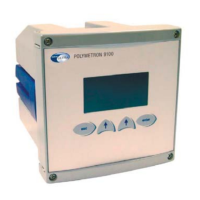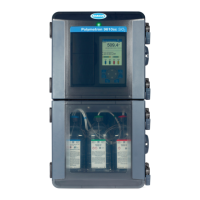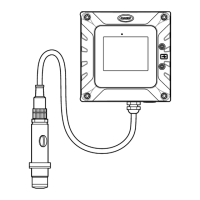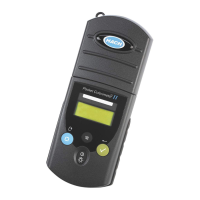Specification Details
Protection rate
Transmitter: IP65 (NEMA 4); Panel: IP50 (dust protection)
Optional Enclosure: IP54 (splash water proof)
Instrument is designed to avoid DIPA vapor inside the enclosure. All DIPA vapor is
collected and sent to the instrument drain
Cell PMMA - compact (minimum tubing)
Flame rate Conform UL
Maximum weight 15 - 30 Kg
Mains power supply 100 - 240 VAC, 50-60 Hz, ± 10%, automatic switching
Max. consumption 80 VA
Fuse 5 x 20 cartridge T2AL-250V following CEI127
Display Last Cal Date, Historical, Concentration, Temperature, Potential
Analog outputs Number: 4; 4-20 or 0-20 mA (650 ohms); Linear / Dual / Logarithm; Smart
Relays 2 x Relay (conc); 1 x Warning; 1 x System
Logic input Start / Standby; Remote AutoCal
EMC requirements
EN61326-1: EMC Directive
Note: This is a Class A product. In a domestic environment this product may cause radio
interference in which case the user may be required to take adequate measures.
N O T I C E
Measurement variations of less than 5% of the full range can occur if the
instrument is subject to a strong electromagnetic field.
Korean registration
User Guidance for EMC Class A Equipment
업무용을 위한 EMC 등급 A 장치에 대한
사용자 지침
사용자안내문
A 급 기기 ( 업무용 방송통신기자재 )
이 기기는 업무용 (A 급 ) 전자파적합기기로서 판매자 또는 사용자는 이 점을 주의
하시기 바라며 , 가정외의 지역에서 사용하는 것을 목적으로 합니다.
CE compliance EN61010-1: LVD Directive
International standards cETLus
Warranty Instrument: 1 year (EU: 2 years)
Electrodes: 6 months
General information
In no event will the manufacturer be liable for direct, indirect, special, incidental or consequential
damages resulting from any defect or omission in this manual. The manufacturer reserves the right to
make changes in this manual and the products it describes at any time, without notice or obligation.
Revised editions are found on the manufacturer’s website.
Safety information
N O T I C E
The manufacturer is not responsible for any damages due to misapplication or misuse of this product including,
without limitation, direct, incidental and consequential damages, and disclaims such damages to the full extent
permitted under applicable law. The user is solely responsible to identify critical application risks and install
appropriate mechanisms to protect processes during a possible equipment malfunction.
4 English

